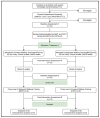A Backward Walking Training Program to Improve Balance and Mobility in Children with Cerebral Palsy
- PMID: 34574964
- PMCID: PMC8465093
- DOI: 10.3390/healthcare9091191
A Backward Walking Training Program to Improve Balance and Mobility in Children with Cerebral Palsy
Abstract
Background: We studied the effects of motor tasks using backward walking training on balance and gait functions of children with cerebral palsy. This was a single-blinded, randomized controlled trial with a crossover design conducted at a single facility.
Methods: Among 12 children with cerebral palsy, the forward (FWG) (n = 6) and backward walking groups (BWG) (n = 6) underwent training three times a week for 4 weeks, 40 min a day. After a 6-week break, the crossover training was conducted. Functional walking variables were measured. Time-Up-and-Go (TUG) test, Figure-8 Walk Test (FW8T), and Pediatric Balance Scale (PBS) were used for measuring balance.
Results: Both groups showed significant improvement in walking speed, stride length, and step length. The BWG demonstrated significant improvement in walking speed (p < 0.05) compared with the FWG. The TUG test, FW8T, and PBS showed significant improvement. After the 4-week intervention, both groups displayed a remarkable decrease in TUG duration and FW8T. Both groups also exhibited improvement in the PBS; more so in the BWG.
Conclusions: Backward walking training with motor dual tasks could be a more effective interventional approach than forward walking training to improve balance and walking functions of children with spastic hemiplegia.
Keywords: backward walking; balance; cerebral palsy.
Conflict of interest statement
The authors declare no conflict of interest.
Figures
Similar articles
-
Effect of Treadmill Backward Walking Training on Motor Capacity in Cerebral Palsy: A Randomized Controlled Study.Ann Rehabil Med. 2023 Apr;47(2):89-97. doi: 10.5535/arm.22154. Epub 2023 Apr 18. Ann Rehabil Med. 2023. PMID: 37070285 Free PMC article.
-
Erratum.Mult Scler. 2016 Oct;22(12):NP9-NP11. doi: 10.1177/1352458515585718. Epub 2015 Jun 3. Mult Scler. 2016. PMID: 26041800
-
Effectiveness of backward walking training on walking ability in children with hemiparetic cerebral palsy: a randomized controlled trial.Clin Rehabil. 2017 Jun;31(6):790-797. doi: 10.1177/0269215516656468. Epub 2016 Jun 29. Clin Rehabil. 2017. PMID: 27356944 Clinical Trial.
-
Effects of backward gait training on balance, gross motor function, and gait in children with cerebral palsy: a systematic review.Clin Rehabil. 2019 Jan;33(1):3-12. doi: 10.1177/0269215518790053. Epub 2018 Jul 25. Clin Rehabil. 2019. PMID: 30043634
-
Addition of backward walking training to forward walking training improves walking speed in children with cerebral palsy: a systematic review with meta-analysis.Int J Rehabil Res. 2023 Dec 1;46(4):300-307. doi: 10.1097/MRR.0000000000000598. Epub 2023 Aug 15. Int J Rehabil Res. 2023. PMID: 37581293
Cited by
-
Neurorehabilitation: Looking Back and Moving Forward, 1st Edition.Healthcare (Basel). 2023 May 17;11(10):1452. doi: 10.3390/healthcare11101452. Healthcare (Basel). 2023. PMID: 37239738 Free PMC article.
-
Dual Task Training Interventions and Mobility-Based Outcomes in Children with Cerebral Palsy: A Scoping Review.Phys Occup Ther Pediatr. 2025;45(5):652-671. doi: 10.1080/01942638.2025.2477792. Epub 2025 Mar 25. Phys Occup Ther Pediatr. 2025. PMID: 40130285 Review.
-
Characterizing the Longitudinal Impact of Backward Locomotor Treadmill Training on Walking and Balance Outcomes in Chronic Stroke Survivors: A Randomized Single Center Clinical Trial.medRxiv [Preprint]. 2024 Sep 13:2024.09.11.24313519. doi: 10.1101/2024.09.11.24313519. medRxiv. 2024. PMID: 39314955 Free PMC article. Preprint.
References
-
- Freeman M. Physical Therapy of Cerebral Palsy. Springer Science & Business Media; Berlin, Germany: 2007.
-
- Rosenbaum P., Paneth N., Leviton A., Goldstein M., Bax M., Damiano D., Dan B., Jacobsson B. A report: The definition and classification of cerebral palsy April 2006. Dev. Med. Child Neurol. Suppl. 2007;109:8–14. - PubMed
-
- Oeffinger D.J., Tylkowski C.M., Rayens M.K., Davis R.F., Gorton G.E., 3rd, D’Astous J., Nicholson D.E., Damiano D.L., Abel M.F., Bagley A.M., et al. Gross Motor Function Classification System and outcome tools for assessing ambulatory cerebral palsy: A multicenter study. Dev. Med. Child Neurol. 2004;46:311–319. doi: 10.1111/j.1469-8749.2004.tb00491.x. - DOI - PubMed
LinkOut - more resources
Full Text Sources
Medical


